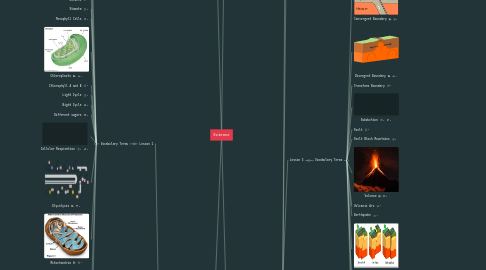
1. Unit 3
1.1. Module 1
1.1.1. Lesson 1
1.1.1.1. Vocabulary Terms
1.1.1.1.1. Natural resource
1.1.1.1.2. Ores
1.1.1.1.3. Renewable Resources
1.1.1.1.4. Nonrenewable resources
1.1.2. Lesson 2
1.1.2.1. Vocabulary Terms
1.1.2.1.1. Hydrothermal deposits
1.1.2.1.2. Subduction Zones
1.1.2.1.3. Distribution of minerals
1.1.2.1.4. Soil
1.1.2.1.5. 5 Factors of soil formation
1.1.2.1.6. Formation of Coal
1.1.2.1.7. Formation of Oil and Natural Gas
1.1.2.1.8. Porosity
1.1.2.1.9. Permeability
1.1.2.1.10. Groundwater
1.1.2.1.11. Groundwater distribution
1.1.3. Lesson 3
1.1.3.1. Vocabulary Terms
1.1.3.1.1. Mining
1.1.3.1.2. Dwindling Deposits
1.1.3.1.3. Mineral Supplies
1.1.3.1.4. Fossil fuel extraction
1.1.3.1.5. Groundwater overdraft
1.2. Module 2
1.2.1. Lesson 1
1.2.1.1. Vocabulary Terms
1.2.1.1.1. Material
1.2.1.1.2. Natural Material
1.2.1.1.3. Synthetic Material
1.2.1.1.4. Reactants to Products
1.2.2. Lesson 2
1.2.2.1. Vocabulary Terms
1.2.2.1.1. Natural Resource Availability
1.2.2.1.2. Synthetic Material Production
1.2.2.1.3. Individual and Societal impacts
1.2.2.1.4. By-products
2. Unit 4
2.1. Module 1
2.1.1. Lesson 1
2.1.1.1. Vocabulary Terms
2.1.1.1.1. Photosynthesis
2.1.1.1.2. Epidermal leaf cells
2.1.1.1.3. Cuticle
2.1.1.1.4. Stomata
2.1.1.1.5. Mesophyll Cells
2.1.1.1.6. Chloroplasts
2.1.1.1.7. Chlorophyll A and B
2.1.1.1.8. Light Cycle
2.1.1.1.9. Night Cycle
2.1.1.1.10. Different sugars
2.1.1.1.11. Cellular Respiration
2.1.1.1.12. Glycolysis
2.1.1.1.13. Mitochondria
2.1.1.1.14. Lactic Acid Fermentation
2.1.1.1.15. Ethanol Alcohol Fermentation
2.1.2. Lesson 2
2.1.2.1. Vocabulary Terms
2.1.2.1.1. Producers
2.1.2.1.2. Consumers
2.1.2.1.3. Primary Consumer
2.1.2.1.4. Secondary Consumer
2.1.2.1.5. Tertiary Consumer
2.1.2.1.6. Detritivores
2.1.2.1.7. Food Chain
2.1.2.1.8. Food Web
2.1.2.1.9. Energy Pyramid / 10 % rule
2.1.3. Lesson 3
2.1.3.1. Vocabulary Terms
2.1.3.1.1. Carbon Cycle
2.1.3.1.2. - Cellular Respiration
2.1.3.1.3. - Photosynthesis
2.1.3.1.4. - Sedimentation
2.1.3.1.5. - Decomposition
2.1.3.1.6. - Fossil Fuels
2.1.3.1.7. - Combustion
2.1.3.1.8. Water Cycle
2.1.3.1.9. - Evaporation / Transpiration
2.1.3.1.10. - Condensation
2.1.3.1.11. - Precipitation
2.1.3.1.12. - Run Off
2.1.3.1.13. - Seepage
2.1.3.1.14. Oxygen Cycle
2.1.3.1.15. - Cellular Respiration
2.1.3.1.16. - Photosynthesis
2.1.3.1.17. Nitrogen Cycle
2.1.3.1.18. - Precipitation
2.1.3.1.19. - Nitrogen Fixation
2.1.3.1.20. - Ammonification
2.1.3.1.21. - Nitrification
2.1.3.1.22. - Assimilation
2.1.3.1.23. - Denitrification
2.2. Module 2
2.2.1. Lesson 1
2.2.1.1. Vocabulary Terms
2.2.1.1.1. Biosphere
2.2.1.1.2. Biome
2.2.1.1.3. Ecosystems
2.2.1.1.4. Communities
2.2.1.1.5. Populations
2.2.1.1.6. Organism
2.2.1.1.7. Abiotic
2.2.1.1.8. Biotic
2.2.1.1.9. Limiting Factor
2.2.1.1.10. Biotic Potential
2.2.1.1.11. Carrying Capacity
2.2.1.1.12. Overpopulation
2.2.1.1.13. Extinction
2.2.1.1.14. Endangered Species
2.2.1.1.15. Threatened species
2.2.2. Lesson 2
2.2.2.1. Vocabulary Terms
2.2.2.1.1. Symbiosis
2.2.2.1.2. Commensalism
2.2.2.1.3. Parasitism
2.2.2.1.4. Mutualism
2.2.2.1.5. Cooperative Relationships
2.2.2.1.6. competitive Relationship
2.2.2.1.7. Predator-prey relationship
2.2.3. Lesson 3
2.2.3.1. Vocabulary Terms
2.2.3.1.1. Ecological succession
2.2.3.1.2. Climax Community
2.2.3.1.3. Primary succession
2.2.3.1.4. Secondary succession
2.2.3.1.5. Eutrophication
2.2.3.1.6. Dynamic Equilibrium
2.2.3.1.7. Resource Extraction
2.2.3.1.8. Pollution
2.2.3.1.9. Nonnative species
2.2.4. Lesson 4
2.2.4.1. Vocabulary Terms
2.2.4.1.1. .
3. Unit 1
3.1. Module 1
3.1.1. Lesson 1
3.1.1.1. Vocabulary Terms
3.1.1.1.1. Matter
3.1.1.1.2. Solid State
3.1.1.1.3. Liquid State
3.1.1.1.4. Gas State
3.1.1.1.5. Kinetic Energy
3.1.1.1.6. Temperature
3.1.1.1.7. Thermometer
3.1.1.1.8. Kelvin Scale
3.1.1.1.9. Potential Energy
3.1.1.1.10. Thermal Energy
3.1.1.1.11. Atoms
3.1.1.1.12. Substances
3.1.1.1.13. Elements
3.1.1.1.14. Compound
3.1.1.1.15. Molecule
3.1.1.1.16. Periodic Table of Elements
3.1.1.1.17. Element Symbols
3.1.1.1.18. Chemical Formula
3.1.2. Lesson 2
3.1.2.1. Vocabulary Terms
3.1.2.1.1. Jacques Charles
3.1.2.1.2. Volume Temperature Law
3.1.2.1.3. Thermal Contraction
3.1.2.1.4. Thermal expansion
3.1.2.1.5. Systems
3.1.2.1.6. Heating
3.1.2.1.7. Pressure
3.1.2.1.8. Phase Change
3.1.2.1.9. Melting
3.1.2.1.10. Freezing
3.1.2.1.11. Condensation
3.1.2.1.12. Vaporization
3.1.2.1.13. Boiling vs. Evaporation
3.1.3. Lesson 3
3.1.3.1. Vocabulary Terms
3.1.3.1.1. Pressure and Volume
3.1.3.1.2. Robert Boyle
3.1.3.1.3. Pressure and Numder of particles
3.1.3.1.4. Pressure and states of matter
3.1.4. Lesson 4
3.1.4.1. Vocabulary Terms
3.1.4.1.1. Molecules
3.1.4.1.2. Nonmetal Gases
3.1.4.1.3. Nonmetal Solids
3.1.4.1.4. Metals
3.1.4.1.5. Ionic Compounds
3.1.4.1.6. Covalent Compounds
3.1.4.1.7. Polar Covalent Compounds
3.1.4.1.8. Nonpolar Covalent Compounds
3.1.4.1.9. Dissolving
3.2. Module 2
3.2.1. Lesson 1
3.2.1.1. Vocabulary Terms
3.2.1.1.1. Qualitative Characteristics
3.2.1.1.2. Quantitative Characteristics
3.2.1.1.3. Mass
3.2.1.1.4. Weight
3.2.1.1.5. Volume
3.2.1.1.6. Density
3.2.1.1.7. Chemical Properties
3.2.1.1.8. Flammability
3.2.1.1.9. Oxidation
3.2.1.1.10. Reactivity
3.2.1.1.11. Solubility
3.2.2. Lesson 2
3.2.2.1. Vocabulary Terms
3.2.2.1.1. Chemical Changes
3.2.2.1.2. Chemical Reactions
3.2.2.1.3. Chemical Equations
3.2.2.1.4. Products
3.2.2.1.5. Reactants
3.2.2.1.6. Coefficients
3.2.2.1.7. Antoine Lavoisier
3.2.2.1.8. Law of conservation of mass
3.2.2.1.9. Atomic Mass
3.2.3. Lesson 3
3.2.3.1. Vocabulary Terms
3.2.3.1.1. Chemical Potential Energy
3.2.3.1.2. Endothermic Reaction
3.2.3.1.3. Exothermic Reaction
3.2.3.1.4. Concentration in reactions
3.2.3.1.5. Law of conservation of energy
4. Unit 2
4.1. Module 1
4.1.1. Lesson 1
4.1.1.1. Vocabulary Terms
4.1.1.1.1. Pangea
4.1.1.1.2. Continental Drift
4.1.1.1.3. Rock formation evidence
4.1.1.1.4. Glacial features evidence
4.1.1.1.5. Coal Deposit evidence
4.1.1.1.6. Fossil Evidence
4.1.1.1.7. Alfred Wegener
4.1.2. Lesson 2
4.1.2.1. Vocabulary Terms
4.1.2.1.1. Ocean Floor topography
4.1.2.1.2. Mid ocean ridges
4.1.2.1.3. Ocean trenches
4.1.2.1.4. Isochron Maps
4.1.2.1.5. Seafloor spreading
4.1.2.1.6. Magma
4.1.2.1.7. Lava
4.1.2.1.8. Plate Tectonics
4.1.3. Lesson 3
4.1.3.1. Vocabulary Terms
4.1.3.1.1. Convergent Boundary
4.1.3.1.2. Divergent Boundary
4.1.3.1.3. Transform Boundary
4.1.3.1.4. Subduction
4.1.3.1.5. Fault
4.1.3.1.6. Fault Block Mountains
4.1.3.1.7. Volcano
4.1.3.1.8. Volcanic Arc
4.1.3.1.9. Earthquake
4.1.3.1.10. Fault Zone
4.1.3.1.11. Landslide
4.1.3.1.12. Tsunami
4.1.3.1.13. Impact Crater
4.1.4. Lesson 4
4.1.4.1. Vocabulary Terms
4.1.4.1.1. Physical Weathering
4.1.4.1.2. Frost Wedging
4.1.4.1.3. Plant Action
4.1.4.1.4. Abrasion
4.1.4.1.5. Wind Abrasion
4.1.4.1.6. Water Abrasion
4.1.4.1.7. Glacial Abrasion
4.1.4.1.8. Chemical Weathering
4.1.4.1.9. Oxidation
4.1.4.1.10. Hydrolysis
4.1.4.1.11. Carbonation
4.1.4.1.12. Erosion
4.1.4.1.13. Deposition
4.1.4.1.14. Small Scale Erosion
4.1.4.1.15. Surface runoff
4.1.4.1.16. Coastal Erosion
4.1.4.1.17. Large Scale Erosion
4.1.4.1.18. Mass Wasting
4.1.4.1.19. Glacial Movement
4.1.5. Lesson 5
4.1.5.1. Vocabulary Terms
4.1.5.1.1. Rock
4.1.5.1.2. Mineral
4.1.5.1.3. Crystallization
4.1.5.1.4. Igneous extrusive rock
4.1.5.1.5. Igneous intrusive rock
4.1.5.1.6. Sedimentary rock
4.1.5.1.7. Lithification
4.1.5.1.8. Compaction
4.1.5.1.9. Cementation
4.1.5.1.10. Metamorphic rock
4.2. Module 2
4.2.1. Lesson 1
4.2.1.1. Vocabulary Terms
4.2.1.1.1. Earthquakes and plate boundaries
4.2.1.1.2. Richter Magnitude scale
4.2.1.1.3. Earthquake magnitude scale
4.2.1.1.4. Moment magnitude scale
4.2.1.1.5. Modified Mercalli intensity scale
4.2.1.1.6. Pancaking
4.2.1.1.7. Liquefaction
4.2.1.1.8. Landslide
4.2.1.1.9. Tsunami
4.2.2. Lesson 2
4.2.2.1. Vocabulary Terms
4.2.2.1.1. Volcano Belts
4.2.2.1.2. Hot Spots
4.2.2.1.3. Mudflows
4.2.2.1.4. Lava flows
4.2.2.1.5. Volcanic Ash
4.2.2.1.6. Volcanic Gases
4.2.2.1.7. Pyroclastic Flows
4.2.2.1.8. Predicting volcanoes - Gas
4.2.2.1.9. Predicting volcanoes - Deformation
4.2.2.1.10. Predicting volcanoes - Ground Vibration
4.2.2.1.11. Predicting volcanoes - Remote Sensing
4.2.2.1.12. Predicting volcanoes - Lava Collection
4.2.3. Lesson 3
4.2.3.1. Vocabulary Terms
4.2.3.1.1. Hurricane
4.2.3.1.2. Saffir-Simpson hurricane scale
4.2.3.1.3. Tornado
4.2.3.1.4. Enhanced Fujita Damage Intensity scale
4.2.3.1.5. Flood
4.2.3.1.6. Drought
4.2.3.1.7. Drought hazard - soil erosion
4.2.3.1.8. Drought hazard - wildfires
4.2.3.1.9. Drought hazard - decrease in water supply
4.2.3.1.10. Drought hazard - agricultural impact
4.2.3.1.11. Meteorologists
